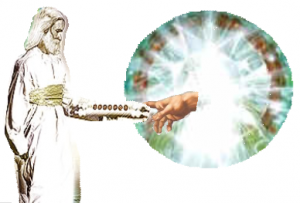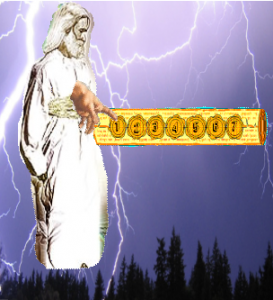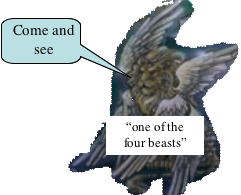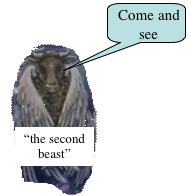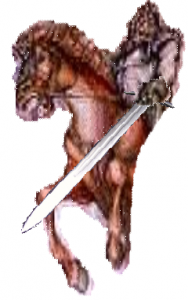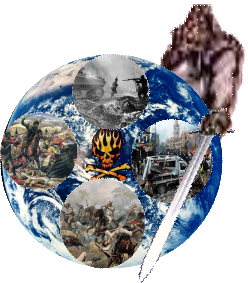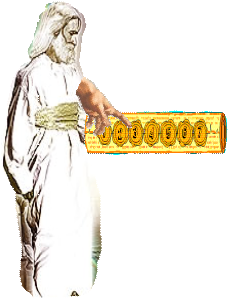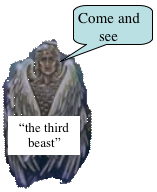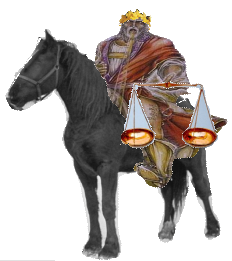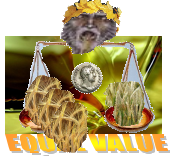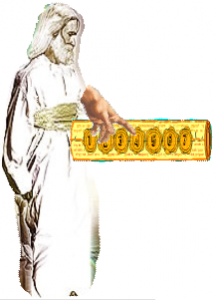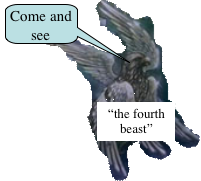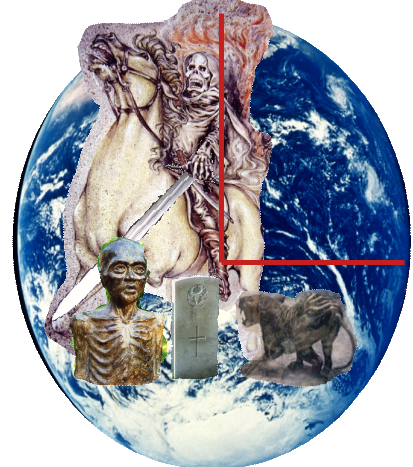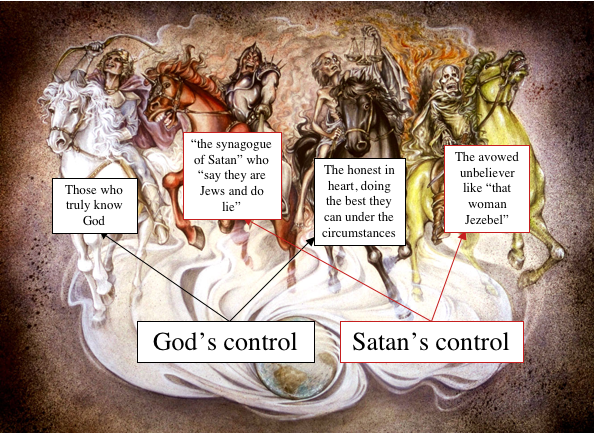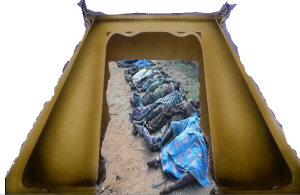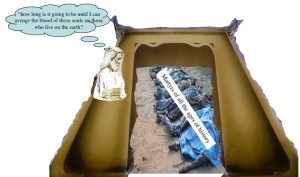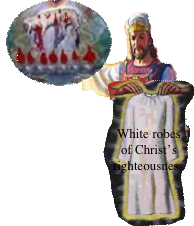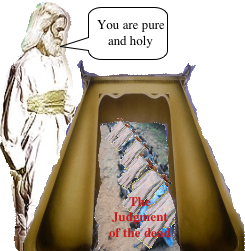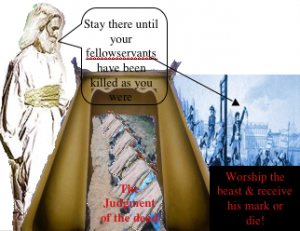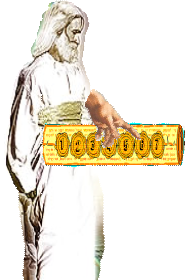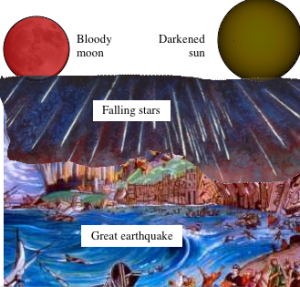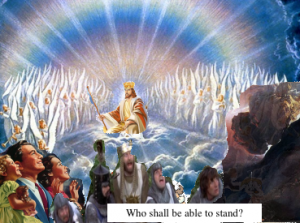Now, the “vision continues with the same setting presented in chs. 4 and 5” [1] when John was invited by Jesus to “behold, a door . . . opened in heaven” to show him “things which must be hereafter” (Revelation 4:1).
Jesus, God the Son, had just come to “him that sat on the throne” in the heavenly sanctuary and had taken “the book out of the Father’s right hand” that was “sealed with seven seals” (Revelation 5:1, 7). We can put a date on it: October 22, 1844.
Many Adventist scholars suggest Revelation 4 and 5 are concerned with “the enthronement of Christ that took place at Pentecost” in 31 A.D. [2] 1813 years earlier in the context of the church of Ephesus. However, as we noted in Revelation 3:21, the scenario of Chapters 4 and 5 begins after Jesus said “I . . . am [already] set down with my Father in his throne” that is clearly in context with the church of Laodicea.
Then Jesus shows us the Father on the throne in Chapter 4 followed, in Chapter 5, with Himself coming to the Father and taking the “book” of records out of the Father’s “right hand.” Nowhere does Jesus depict Himself being enthroned either in Chapter 4 or 5. Obviously, when He “came and took the book,” He must have been standing even though He had already been enthroned in His office according to Revelation 3:21.
With that background in mind, let’s turn our attention to Chapter 6.
Verse 1: And I saw when the Lamb opened one of the seals, and I heard, as it were the noise of thunder, one of the four beasts saying, Come and see.
Note, it is the “Lamb,” who not only opens this seal, He (denoted in the remaining seals by the personal pronoun “he”) opens all of them. Why? In addition to the affirmation of the heavenly inhabitants in Chapter 5:9, that He is “worthy,” we should also remember that “the Father judgeth no man, but hath committed all judgment unto the Son” (John 5:22).
Note the absence of any references or parallels to the “church of Ephesus” (Revelation 2:1). Rather, this verse directs our attention to Revelation 5:7 where Jesus just took “the book out of the right hand of him that sat upon the throne” and now commences to open “one of the seals.” Neither is there any mention of His having taking His position on the throne next to the Father.
He then commences to open “one of the seals.” Obviously, it must be seal number one because all the rest are numbered, starting with “two.” We must not assume that neglecting number “one” is a mistake, rather it is intentional. It implies, at least for the first four seals, that their sequence is irrelevant and that they are really contemporaneous! More on that shortly.
The “noise of thunder,” accompanying the opening of this seal, reminds us of the “lightnings and thunderings and voices” seen and heard when John first described God’s throne (Revelation 4:5). Significantly, no more “thunder” will be heard until “the angel [takes] the censer . . . and cast[s] it into the earth” (Revelation 8:5) at the end of the Investigative Judgment beginning here.
Then John hears “one of the four beasts” inviting him to “Come and see.” These beasts were introduced back in Chapter 4, with the “first” looking “like a lion,” the “second . . . like a calf,” the “third” as “a face as a man” and the “fourth . . . like a flying eagle,” in that order.
So, instead of looking to the seven churches for parallels, let’s turn to the parallel “four living creatures” of Ezekiel, and see how he listed them. First, was “the face of a man,” then “the face of a lion,” followed by “the face of an ox” and then “the face of an eagle” (see Ezekiel 1:10). Later “the first face was the face of a cherub, and the second face was the face of a man, and the third the face of a lion, and the fourth the face of an eagle” (see Ezekiel 10:14). Later still, only “the face of a man” and “the face of a young lion” are depicted (Ezekiel 41:19). Therefore, even though John listed the “lion” as “first,” Ezekiel listed it second, then third, and finally second (Ezekiel 1:10; 10:14 and 41:19).
While John lists the “calf” as “second,” Ezekiel lists it third (Ezekiel 1:10), then first (as a “cherub”? Ezekiel 10:14), but it is not listed at all in Ezekiel 41:19.
While John lists the “face as a man” as “third,” Ezekiel lists it first, then third, then first (Ezekiel 1:10; 10:14 and 41:19).
Interestingly, both John and Ezekiel list “the fourth beast . . . like a flying eagle” (Revelation 4:7, Ezekiel 1:10 and 10:14), although Ezekiel later omits mention of it, as well as the “ox” (Ezekiel 41:19).
Therefore, whereas John neglects to signify the “lion” as “first” in this chapter (identifying it as “one of the four beasts”), and Ezekiel signifies it as “second, third” and “second” in his visions, the order of its presentation should not be regarded as a significant factor in Revelation or Ezekiel.
While the lack of sequence here seems at first to be a matter of minor significance, bear in mind that the traditional (recapitulation view) understanding, which depends on the exact order in sequence with the seven churches, might be one of those concepts we do well to question.
Verse 2: And I saw, and behold a white horse: and he that sat on him had a bow; and a crown was given unto him: and he went forth conquering, and to conquer.
This verse introduces the first of the famous “four horses of the apocalypse” frequently referred to, even in secular literature.
To begin with, if the order of the “four beasts” is not significant, the same must apply to the four horses, even though the “red, black” and “pale” are presented by the “second, third,” and “fourth” beasts.
A brief survey of the first four seals (Verses 2-8) ―each horse a different color, all bearing riders, three with weapons and one having a balance―suggests conflict of some kind, as if going to war. In general, Seventh-day Adventists have held that they represent the first periods of the Christian era and parallel the four churches―Ephesus, Smyrna, Pergamos and Thyatira. According to that understanding, the “white horse” period represents the time between 31 to 100 A.D. [3]
However, if our conclusion that Chapter 5 depicts the Investigative Judgment, beginning in 1844 when Jesus “came and took the book out of the right hand of him that sat upon the throne” (Revelation 5:7), we should be willing to reconsider the traditional belief that the horses are parallel to the first four churches, but rather are figurative representations of the character and behavior of people and the God who controls them. Such a view makes the last church (Laodicea) a transition point between the seven churches and the seven seals.
Instead of looking to the seven churches for parallels, let’s turn to the book of Zechariah where other symbolic horses are depicted. Some “white horses” are mentioned last in Zechariah 1:8, “third” in 6:3 and second in 6:6. Note that “they answered the angel” saying “we have walked to and fro through the earth” (Zechariah 1:11), suggesting their ability to speak. Another distinctive feature of Zechariah’s horses is that they are “in” (or with) the “chariot” (see Zechariah 6:2, 3) [4] which is unlike these horses which bear riders.
Let’s ask ourselves: are these differences complementary or exclusionary? Are the differences so great we must conclude John’s “white horse” cannot be parallel to Zechariah’s “white horses”? I suggest they are parallel because the figure of a “white horse” or “horses” is found only in Revelation 6:2 and 19:11, 14 and Zechariah 1:8 and 6:3 and does not appear anywhere else in the Bible.
The color of this horse is also significant― “white” signifying the color of Jesus’ hair in Revelation 1:14, the color of the “stone” promised the overcomer in Revelation 2:17, the lifestyle of the overcomer in Revelation 3:4, the color representing Christ’s righteousness that clothes the overcomer, the purity of life after Jesus cleanses it with His blood in Revelation 3:18, the color of a “cloud” Jesus sits on in Revelation 14:14, the color of the good angel’s clothing in Revelation 15:6, the color of the “white horse” Jesus sits on in Revelation 19:11, the color of other “white horses” that follow Jesus in Revelation 19:14 and the color of God’s throne in Revelation 20:11.
Therefore, the whiteness of the “white horse” must represent the righteousness and purity of Christ’s character and behavior. Corollary with that, the “white horse” must also represent the saints who fully accept His righteousness and are cleansed from their sins. Note how Joel portrays the Lord’s “army” (Joel 2:4, 11): “The appearance of them is as the appearance of horses; and as horsemen, so shall they run.”
But, what about the rider who had “a bow” and “a crown” that was “given unto him”? Obviously, he is in control of the horse that obeys the command of the rider and not vice versa. Given the righteous character of the white horse, God must be the One in control of this horse. However, the “bow” is a bit more difficult to explain. Although it appears to be a weapon, [5] no arrow is depicted. So, what good is a “bow” without an arrow? A passage in Habakkuk 3:9 is helpful here: “Thy bow was made quite naked, according to the oaths of the tribes, even thy word. Selah.” If the “bow” represents God’s “word,” it is infinitely powerful because: “By the word of the LORD were the heavens made; and all the host of them by the breath of his mouth” (Psalms 33:6).
Note also that the “name” of Him that “sat upon” the “white horse” in Revelation 19:11 “is called The Word of God” “And out of his mouth goeth a sharp sword, that with it he should smite the nations:” (Revelation 19:13, 15). Therefore, the “bow” (God’s Word) is by far the most potent weapon in the universe, suggesting that the “white horse” rider is able to create as well as destroy.
The “crown,” from the Greek word “stephanos,” [6] is the same promised the courageous Smyrnans whom Jesus encouraged: “Fear none of those things which thou shalt suffer . . . be thou faithful unto death, and I will give thee a crown of life” (Revelation 2:10). The Commentary observes it to be “’a chaplet,’ or ‘garland, of victory,’ not a diadem of rulership. This word was used for the wreaths given to victors in Greek games. Here, it is a symbol of the reward given to the victor in their struggle with Satan.” [7]
The remarkable thing is that this same “crown” is “given” the omnipotent rider of the “white horse.” He overcame Satan even as we are charged to do. “To him that overcometh will I grant to sit with me in my throne, even as I also overcame and am set down with my Father in his throne” (Revelation 3:21).
Since “he [not “they”] went forth conquering, and to conquer” suggests the rider is omnipotent as well as continuously victorious with the personal pronoun “he” implying all credit goes to the rider, not the horse. So, while it might be said this horse represents “the church in the apostolic age,” [8] the application is strained because that church “left” its “first love” (Revelation 2:4), whereas this “horse” submits to its rider continually, without interruption.
The following quote seems to apply here: “While much of the fruit of their labor is not apparent in this life, God’s workers have his sure promise of ultimate success. As the world’s Redeemer, Christ was constantly confronted with apparent failure. He seemed to do little of the work which he longed to do in uplifting and saving. Satanic agencies were constantly working to obstruct his way. But he would not be discouraged. Ever before him he saw the result of his mission. He knew that truth would finally triumph in the contest with evil, and to his disciples he said: ‘These things I have spoken unto you, that in he ye might have peace. In the world ye shall have tribulation: but be of good cheer; I have overcome the world.’ The life of Christ’s disciples is to be like his, a series of uninterrupted victories, not seen to be such here, but recognized as such in the great hereafter.” [9]
So, in the progressive view, this horse represents the character and behavior of those who have lived throughout the ages: “In every age there have been faithful men to stand as God’s witnesses in the earth.” [10] They are the individuals who had submitted and continue to submit to the rider’s control “from the beginning of earth’s history to its close.” [11] They are like “the people that do know their God” and “shall be strong, and do exploits” and “they that understand among the people [who] shall instruct many” (Daniel 11:32, 33) during the final hours of earth’s history.
We could even go so far as to say that the end time white horse people are represented by the 144,000 (Revelation 7:4-8).
Verse 3: And when he had opened the second seal, I heard the second beast say, Come and see.
In Verse 1 “the Lamb opened [only] one of the seals” and only “one of the four beasts” is heard from. Although that seal is not designated as number one, it becomes number one by default because the next seal is the “second.” This suggests, as we noted before, that sequence of opening (at least as far as the first four seals are concerned) is not as important as we might have thought. Evidently, the numbering of the horses serves more for identification rather than succession or sequence.
“The second beast [was] like a calf,” identified in Revelation 4:7. He, like the “first beast . . . like a lion” that was “full of eyes before and behind” (Revelation 4:6, 8), must also represent supernatural intelligence and insight. The invitation “Come and see” could be understood to say: “Come and see” what I see.
The word “come” is from “erchomai.” [12] It is used thirty-seven times in Revelation, mostly as a statement of what God will do, rather than an invitation. But one other time it is used as an invitation, as we see here and in Verses 1, 5 and 7. There, “the Spirit and the bride say, Come. And let him that heareth say, Come. And let him that is athirst come. And whosoever will, let him take the water of life freely” (Revelation 22:17).
Verse 4: And there went out another horse that was red: and power was given to him that sat thereon to take peace from the earth, and that they should kill one another: and there was given unto him a great sword.
In contrast to the “white horse,” which is paralleled by the “white horse” of Revelation 19:11, there is no parallel to the “horse that was red” in the book of Revelation. However, “a red horse” and “red horses” are depicted three times in Zechariah 1:8 and 6:2. They, along with the other horses, all say: “We have walked to and fro through the earth,” evidently, simultaneously with the other horses, not sequentially. It is reasonable, therefore, to conclude “the horse that was red,” in this verse, is also walking “to and fro through the earth” at the same time the “white horse” is walking “to and fro,” instead of following it.
Although another “red horse” is not found in the book of Revelation, we do find another animal that is “red.” It is the “great red dragon . . . called the Devil, and Satan” (Revelation 12:3, 9). Therefore, like the “white” color of the first “horse,” which represents purity of character, “red” [13] could well represent the character of Satan.
Who is the rider that “was given . . . to take peace from the earth? Note what John says about peace: “Grace be unto you, and peace, from him which is, and which was, and which is to come” (Revelation 1:4). The “peace” giver, in that context, is obviously Christ. Here, the rider takes “peace from the earth.” Consequently, he cannot be Christ. Therefore, he must be Satan.
Then we see that “they should kill one another:” Who are “they”? Evidently the people represented by “the horse that was red” who are incited by the rider to “kill one another;” [14] all of whom are characterized by the red horse.
The negative connotation of the red horse is heightened when we examine the word “kill” translated from “sphazo” [15] meaning: “to slay, slaughter, butcher, to put to death by violence” and “mortally wounded.” It is translated “slain” (Revelation 5:6, 9, 12) where the “Lamb” was “slain” by Satan through his human agents, the religious leaders of Israel, and the mob they incited who “cried, saying, Crucify him, crucify him” (Luke 23:21; John 19:6).
Then, “there was given unto him a great sword.” Many believe this refers to a “sword” belonging to Jesus who said to His disciples, just before sending them out on their first missionary journey: “Think not that I am come to send peace on earth: I came not to send peace, but a sword” (Matthew 10:34), which must be “the sword of the spirit, which is the word of God” (Ephesians 6:17). In contrast, this “sword” appears to represent a literal, physically lethal weapon.
Remember, Jesus told Peter to “put up again thy sword into his place: for all they that take the sword shall perish with the sword” (Matthew 26:52). Later on He told Pilate: “if my kingdom were of this world, then would my servants fight, that I should not be delivered to the Jews: but now is my kingdom not from hence” (John 18:36). He was speaking, in that context, of literal weapons and literal war.
So, the “sword” given the rider of the “horse that was red” cannot be the words of God, rather it is representative of satanic behavior―the use of force, fear and intimidation, rather than the word of God.
The closest parallel to the red horse is “the synagogue of Satan,” those who “say they are Jews and are not but do lie” (See Revelation 2:9; 3:9), the hypocritical believers in God, much like “them that forsake the holy covenant” (Daniel 11:30) or the Pharisees who dogged the life of Christ all during his public ministry.
Verse 5: And when he had opened the third seal, I heard the third beast say, Come and see. And I beheld, and lo a black horse; and he that sat on him had a pair of balances in his hand.
The personal pronoun “he” is still the “Lamb,” the great unsealer, or book opener, of all seven of the book’s seals, first mentioned in Chapter 5, who was judged “worthy to take the book, and to open the seals thereof” (Revelation 5:9), when “the judgment was set and the books were opened” (Daniel 7:10).
This “third beast had a face as a man” (Revelation 4:7), who, together with the others “gave glory and honour and thanks to him that sat on the throne,” and later “fell down before the Lamb . . . and . . . sung a new song” to Him (Revelation 5:8, 9).
Like the Lion and Calf beasts, he says “Come and see” what I see. Now, compare the “black horse” with the other three. Note that the “white horse” went forth.” The “horse that was red” “went out.” The “pale horse” was “followed.” Therefore, the white, red and pale horses were all moving. Not so with the “black horse.” It, regardless of how the artists have portrayed it, and as far as we can tell, is motionless.
Then we see “balances in” the “hand” of the rider. While the Commentary suggests they symbolize the “spiritual condition within the church after the legalization of Christianity in the [fourth] century,” [16] a far more applicable example is found in Daniel 5:27 where Belshazzar was told “thou art weighted in the balances, and art found wanting.” Obviously, it was Belshazzar’s character and behavior that was “weighed” or judged. In this case, it is the character and behavior of the people, represented by the “horse that was black,” being weighed or judged.
Consider Job who asked God to weigh him “in an even balance, that God may know mine integrity” (Job 31:6). David declared that “men of low degree” and “high degree” are “to be laid in the balance . . .” of God’s judgment (Psalms 62:9).
“God weighs every man in the balances of the sanctuary. In one scale is placed his perfect, unchangeable law, demanding perfect obedience. If in the other there are years of forgetfulness, of rebellion, of self-pleasing, with no repentance, no confession, no effort to do right, God says, ‘Thou are weighted in the balances, and art found wanting.’” [17][18]
So, who is the one who “sits” on the “black horse”? It cannot be Satan who cares nothing about evaluating moral worth. In fact, the more moral worth, the more he hates them. Therefore, it must be the same person who sits astride the “white horse,” namely the Person who wrote the word “TEKEL” (Daniel 5:27) on the wall of the palace in Belshazzar’s last day.
But, what about the “black horse” itself? Clearly, it is God who holds the balances and the fact that He “sat on him” suggests He is in control of that “horse” and is the same Person astride the “white horse” of Verse 2. That being the case, this horse’s blackness cannot represent “defeat or . . . corruption of faith,” as the Commentary suggests [19], because God does not corrupt in any sense of the word. Furthermore, if God is in control, as we see represented here, He cannot be defeated any more than the “white horse” who “went forth conquering and to conquer.” Consequently, we must come up with a better explanation for the blackness of the “black horse.”
Apparently, the most logical explanation is that blackness or darkness represents the absence of light―in this case, the light of truth. Therefore, the “black horse” represents people who are excusably ignorant of the truth about God, in contrast to the “white horse” people who are “filled with the knowledge of his will in all wisdom and spiritual understanding” (Colossians 1:9). Consequently, the “black horse” can well be understood to represent the “many” who receive instruction from “they that understand among the people” (Daniel 11:33).
They are the people living in “the times of this ignorance [which] God winked [20] at” (Acts 17:30) or overlooked. Even while Jesus was on the cross, He prayed the “Father” to “forgive them” that hung Him on the cross because “they know not what they do” (Luke 23:34). Peter even excused them that “killed the Prince of life” because that “through ignorance ye did it . . .” (Acts 3:15, 17). Later on, many of those responsible for His crucifixion gave their hearts to Jesus because even “a great company of the priests were obedient to the faith” (Acts 6:7) after all was said and done.
But not all ignorance is excusable. Paul referred to it as “the ignorance that is in them, because of the blindness of their heart” (Ephesians 4:18). Peter referred to “the ignorance of foolish men” (1 Peter 2:15). That kind of ignorance is certainly inexcusable. Jesus said: “this is the condemnation, that light is come into the world, and men loved darkness rather than light, because their deeds were evil” (John 3:19), which is inexcusable.
Consider these wonderful statements: “A heathen woman living up to the best light she had was in a more acceptable state with God than the widows of Israel, who had been blessed with special privileges and great light, and yet did not live according to the light which God had given them.” [21]
“Among the heathen are those who worship God ignorantly, those to whom the light is never brought by human instrumentality, yet they will not perish. Though ignorant of the written law of God, they have heard His voice speaking to them in nature, and have done the things that the law required. Their works are evidence that the Holy Spirit has touched their hearts, and they are recognized as the children of God.” [22]
“There are many who have never had the light. They are deceived by their teachers, and they had not received the mark of the beast. The Lord is working with them; He has not left them to their own ways. Until they shall be convicted of the truth, and trample upon the evidence given to enlighten them, the Lord will not withdraw His grace from them.” [23]
“I saw that God has honest children among the nominal Adventists and the fallen churches, and before the plagues shall be poured out, ministers and people will be called out from these churches and will gladly receive the truth. Satan knows this; and before the loud cry of the third angel is given, he raises an excitement in these religious bodies, that those who have rejected the truth may think that God is with them. He hopes to deceive the honest and lead them to think that God is still working for the churches. But the light will shine, and all who are honest will leave the fallen churches, and take their stand with the remnant.” [24]
Note an interesting parallel to this horse with the “black horses” of Zechariah. He says they were “in the second chariot” and “go forth into the north country; and the white go forth after them” as if to rescue them (Zechariah 6:6). [25]
All of this coincides well with the motionless “black horse” who seems to be wondering where he should be going. Evidently, he has not made his final decision. Later on, we will discover evidence to conclude his color becomes white when circumstances open the way.
Verse 6: And I heard a voice in the midst of the four beasts say, A measure of wheat for a penny, and three measures of barley for a penny; and see thou hurt not the oil and the wine.
This is the “voice” of the “Lamb” which John previously saw standing “in the midst of the throne, and of the four beasts” (Revelation 5:6). Now, while holding “a pair of balances” (Verse 5) and sitting on the “black horse,” He announces His judgment of the people represented by the “black horse,” the honest in heart who are doing the best they can with the limited privileges and opportunities that come their way. As we can see, the language He uses is highly symbolic, [26] reminiscent of the agricultural terms He used, such as the “wheat” and “tares” (Matthew 13:33-42) and “Thrust in thy sickle, and reap: for the time is come for thee to reap; for the harvest of the earth is ripe” (Revelation 14:15). Here He calls them: “wheat” and “barley;” crops which stand in the field of the world, just as the “black horse” who is standing waiting to be harvested. This links us to words of Jesus: “Lift up your eyes, and look on the fields; for they are white already to harvest” (John 4:35). Whether those “fields” held “wheat” or “barley” made no difference. Both represent souls waiting to hear the gospel and be brought into His fold.
Note that “a measure of wheat” and “three measures of barley” are of equal value: “a penny.” While “barley” is considered “cheaper than wheat” [27], monetarily speaking, in terms of human value it simply means they are more abundant than “wheat.” Therefore, they symbolize the “common people” who heard the Lord “gladly” (Mark 12:37). In God’s sight, they are just as valuable as the less common represented by the “wheat.”
“The Lord’s people are mainly made up of the poor of this world, the common people. Not many wise, not many mighty, not many noble are called.” [28] So, although not many wise, mighty or noble are “called,” there are some! And they are just as valuable as the more numerous “barley.”
While Christ referred to wheat in His illustrations, He did not refer to barley in that manner, possibly because of its somewhat derogatory connotation. But consider Judges 7:13 where Gideon heard a man telling his companion in the enemy’s camp: “Behold, I dreamed a dream, and, lo, a cake of barley bread tumbled into the host of Midian, and came unto a tent, and smote it that it fell, and overturned it, that the tent lay along.” Quite likely, the “host of Midian” considered Gideon and his army greatly inferior to theirs. But, as the story goes, this suggests God can do marvelous things even with the humble (barley cake) type of people.
Looking further into the book of Revelation, we see two groups of God’s people listed as the 144,000 and the “great multitude which no man could number” (Revelation 7:4, 9). “Notwithstanding the spiritual darkness and alienation from God that exist in the churches which constitute Babylon, the great body of Christ’s true followers are still to be found in their communion.” [29]
Then again in Daniel 11:32 and 33 we see two groups: “they that understand among the people shall instruct many:” with the “strong” instructors comprising one group and “many” who make up the latter. The “many” may be likened to “the Gentiles, which have not the law, [but] do by nature the things contained in the law, these, having not the law, are a law unto themselves . . . their thoughts the mean while accusing or else excusing one another” (Romans 2:14, 15).
Christ used the “penny” symbolically (Matthew 20:2-13). Those who had worked only a few minutes in His vineyard were paid the same as those who had worked all day. In other words, Christ valued them all equally regardless of the quantity of their labor.
Then the Lord cautions, “see thou hurt not the oil and the wine.” Who is He referring to by the pronoun “thou”? Probably to the people represented by the “white horse” who are not ignorant of the Lord’s requirements and may be tempted to exercise criticism and harsh judgment.
The word “hurt” which is from the Greek word “adikeo.” It is translated a number of ways as: “wrong, [30] wronged, [31] done . . . wrong, [32] do . . . wrong, [33] did . . . wrong, [34] offender, [35] ye . . . wrong, [36] injured, [37] hurt, [38] should . . . hurt,” [39] and “unjust.” [40] All of them, with the possible exception of Revelation 7:3 and 9:4, pertain to sin and punishment of people, not things such as literal grass, trees, sea, oil or wine. Indeed, White took the human view of this item of symbolic language: “In view of the infinite price paid for man’s redemption, how dare any professing the name of Christ treat with indifference one of His little ones? How carefully should brethren and sisters in the church guard every word and action lest they hurt the oil and the wine!” [41] In other words, she used this language to portray people living in difficult and unfavorable circumstances who we must treat with the utmost tender loving care. To do otherwise is to sin against them.
This all means “God is no respecter of persons” (Acts 10:34) regardless of privileges, circumstances or background.
Verse 7: And when he had opened the fourth seal, I heard the voice of the fourth beast say, Come and see.
This is still Jesus who had come and taken “the book out of the right hand of him that sat upon the throne” (Revelation 5:7). As He proceeds to open the seals, we should consider what the opening of each successive seal means.
Obviously, the book itself cannot be opened until the very last seal has been loosed. Nevertheless, what is revealed when each seal is opened is surely representative, in a very symbolic, pictorial manner, what is written inside the book.
While it is impossible to know the exact details of what is “written within and on the backside” (Revelation 5:1), until all have been loosed, the symbols presented give us a good sense of the character and behavior of the people whose record lies within. Therefore, what is seen when the seals are opened could be considered something like multiple titles to the book. The old saying that “a picture is worth a thousand words” certainly holds true in the seven seals of the book of Revelation.
Even though there are three more “seals” to the “book,” this is the last time we hear from one of the “four beasts.” This one is “like a flying eagle” (Revelation 4:7), in contrast to the other three which were like a “lion,” “calf” and “face as a man,” but it offers the same invitation as the others to “Come and see” what I see. As its vulture like appearance [42] suggests, what we “see” in the next verse is not pretty.
Verse 8: And I looked, and behold a pale horse: and his name that sat on him was Death, and Hell followed with him. And power was given unto them over the fourth part of the earth, to kill with sword, and with hunger, and with death, and with the beasts of the earth.
Surprisingly, the word “pale” is from “chloros” [43] translated “green” in Mark 6:39 and Revelation 8:7 and “green thing” in Revelation 9:4. Just why the “pale” color was chosen here might be due to the macabre name of the rider, for “pale” is the color of a dead body drained of blood, while “green” suggests health and prosperity.
Regardless of the dispute over its color, it is not healthy as the name, “Death,” implies. Adding to the ghastly scene, “Hell followed with him,” not “them,” with the personal pronoun “him” being a reference to the rider named “Death.” “Hell” [44] is the destiny of those who follow with the rider who is obviously Satan, the real author of “Death.” He was the author or originator of “death” (the absence of life), because such a thing was never known in the universe until he inspired Cain to kill his brother Abel (Genesis 4:8).
As the Commentary observes: “Death and hell are here personified and represented, the one as a rider on the horse, and the other as following along.” [45] If the rider’s name is “Death,” Satan is the obvious candidate for such a name while “Hell,” the permanent place of those who suffer the “second death,” seems to coincide with a foreboding of doom. The “horse” itself must represent the people who are fully controlled by the devil.
Therefore, those persons share Satan’s name “Death.” His followers named “Hell” know “the depths of Satan,” the “doctrine” taught by “that woman Jezebel” (Revelation 2:20, 24). The hopelessness of the “second death” is illustrated by the noun “hell.”
A puzzling note is given here that “power,” [46] or liberty “was given unto [both of] them,” that is, the rider and the horse, since “Hell,” being inanimate, has no volition of its own. This is in contrast to the riders of the “white” and “red” horses whose authority or task was given only to the riders, exclusive of the horses. In the case of the “black horse,” no specific power or task is assigned it. Thus, since liberty is given both the pale horse and its rider, there must be some lack of unity between them, suggesting that “Death” might have some difficulty controlling the horse. But what does it matter? “Hell” is their destiny, because both “death and hell were cast into the lake of fire. This is the second death” (Revelation 20:14).
Since it is God who gave “them” their “power,” it should be assumed He permitted it rather than mandating “them” to “kill” by “sword, hunger, death, and with the beasts of the earth.” The Commentary observes: “The phrase ‘to kill . . . with death’ seems hardly to make good sense.” It attempts to resolve the problem “by understanding the word translated ‘death,’ thanatos, here, as meaning ‘pestilence.’” [47] It addresses the same problem in Revelation 2:23 in the same way [48], although no evidence can be presented other than to say the “difficulty probably is resolved” in that manner. However, “thanatos” is the same word translated “Death” for the rider’s name, and it is never translated “pestilence” anywhere in the New Testament. It seems better to consider the “power . . . to kill . . . with death” is the power to thrust their victims into the “second death” (Revelation 2:11; 20:6, 14; 21:8) from which there is no possible escape. Later on we will be learning about the metaphoric “bottomless pit” which seems to coincide with that very concept.
But what is meant by this horse and rider having “power over the fourth part of the earth”? Interestingly, the words “fourth part” are translated from one Greek word “tetarots” [49] or “the fourth.” The Commentary observes it “probably signif[ies] a wide area of the earth.” [50] In other words, the phrase “fourth part of the earth” is literal for a quarter of the world’s population or nations, that from the Bible’s perspective is a killing field. In that area people die from a “progressive deterioration of civilization that follows warfare. The ravages of the sword, killing men and destroying crops, produce hunger; hunger, resulting in the breakdown of health, brings pestilence; and when pestilence has taken its toll, human society is so weakened that it cannot protect itself against the inroads of wild beasts.” [51]
As we think of the various nations of the world that seem to bear an inordinate burden of life’s woes, it is not difficult to conclude that the “third world countries,” [52] who worship the devil under such names as Hinduism, Buddhism, Islam, Shintoism, etc., come under this definition. They, who often suffer from “sword, famine” and danger even from wild animals, are not prosperous countries. In other words, paganism or Satan worship is the god they inadvertently or overtly follow. Satan’s law of “life” is actually the law of “death” which he instituted to counter God’s law, the law of life and liberty.
Instead of the pale horse representing “a particular period of Christian history . . . from about 538 to 1517 . . .” [53], it seems more reasonable to apply the “pale horse” to a mindset that began with “Cain” who “went out from the presence of the LORD” (Genesis 4:16) to establish a kingdom in direct opposition to God. That has been characteristic of a relatively large segment of humanity ever since the time of Cain. The pale horse, therefore, appears to represent the avowed unbeliever, like “that woman Jezebel” (Revelation 2:20).
Here we come to the end of the four-horse scenario depicted in the first four seals of the “book” that was taken by Jesus from “the right hand of him that sat upon the throne” (Revelation 5:1, 7). Irrespective of the customary understanding that they represent four successive periods in the history of the Christian church, it is intuitive, as depicted in this painting (even though some of the details are often incorrect), that most artists show them to be contemporaneous with each other, rather than successive. Could the artist’s understanding, that portrays them together rather than sequential, be the correct concept? This portrayal more accurately represents their function of representing the character and behavior of “every kindred, and tongue, and people, and nation” (Revelation 5:9) from the beginning to the very end of world history. They did not evolve sequentially, one after the other, but manifested themselves all at the same time.
In summary: two horses, the “white” and the “black” are under God’s control, while the other two, the “red” and the “pale,” are controlled by Satan. The distinctive appearances of the “four beasts” who invite us to “Come and see” are informative. The lion-like beast shows the “white horse.” The calf-like beast shows the “red horse,” the man-like beast shows the “black horse,” and the “flying eagle” shows the pale. It, therefore, seems significant that there is a correlation between the for beasts and the tribes of Israel: Judah – lion, Ephraim – calf/ox, Reuben – man-like, Dan – eagle. The lion/Judah/white horse and Reuben/man/black horse are listed with the tribes of Israel represented in the 144,000 (Revelation 7:5), while the tribes of Ephraim/calf-ox/red horse and Dan/eagle/pale horse are not found in that list.
The Lamb begins to open “the book” which contains “the roll of the history of God’s providences, the prophetic history of nations and the church” and “In symbolic language was contained in that roll the influence of every nation, tongue, and people from the beginning of earth’s history to its close.” [54] It seems fair to conclude that the four horses of the apocalypse are symbolic representations of “every nation, tongue, and people from the beginning of earth’s history to its close.”
Therefore, there is ample reason to believe that the four horses of John’s vision are contemporaneous with each other, and not sequential as we have usually believed. They also set the stage for understanding much of what we will find in the remainder of the book of Revelation. There we will see depicted the behavior and characters of “white horse” nations and people, “black horse” nations and people, “red horse” nations and people, and “pale horse” nations and people.
Verse 9: And when he had opened the fifth seal, I saw under the altar the souls of them that were slain for the word of God, and for the testimony which they held:
Having concluded that the first four seals, depicting the four horses and their riders, are contemporaneous with each other, what about the last three? It is apparent that they are sequential, in contrast to the previous four, because they depict events which follow one after the other, rather than taking place simultaneously.
In contrast to the previous four seals, of which she says nothing, White has something to say about the fifth: “Here were scenes presented to John that were not in reality but that which would be in a period of time in the future.” [55] This is in contrast to the first four which symbolize the reality of human nature throughout time. In another quote she observes: “After this [the fifth seal] came the scenes [of the sixth seal?] described in the eighteenth of Revelation, when those who are faithful and true are called out from Babylon.” [56] That, of course, is reference to the “loud cry” scenario (Revelation 18:1-4). Therefore, from White’s perspective, the “fifth seal” points to a time scenario which is still future! The Commentary states: “It appears that the symbolization of the fifth seal was presented to encourage those who faced martyrdom and death, with the assurance that despite the seeming triumph of the enemy, vindication would ultimately come . . . reassurance that the cause of God would ultimately triumph.” [57]
The only element that the last three seals have in common with the first four is that the Lamb opens all of them. While “he” (the same “Lamb” of Verse 1) “opened the fifth seal” none of the “four beasts” say “Come and see.” Neither are any more horses or riders depicted; only, in this one, are “souls” seen lying “under the altar.” Since they had been “slain for the word of God, and for the testimony which they held,” they are martyrs. Nothing in this verse tells us which martyrs, therefore it is perfectly consistent to say that all the martyrs who have ever died throughout history, from Abel, in Adam’s time, to the present.
Why are they seen “under the altar,” and what “altar” is represented? The Commentary dismisses the questions saying: “Rules of interpretation do not require us to locate a specific altar in a certain location at a particular moment of history. As with the details of a parable, not all features of a prophetic symbolization necessarily have interpretative value.” [58] Uriah Smith, quoting Adam Clarke, goes so far as to say that this “altar is upon the earth, not in heaven” [59]. The “altar,” when seen in the context of the judgment scene (Revelation 4 & 5), with Jesus acting as judge and advocate, does have great “interpretative value” when seen in the light of the judgment.
Since the earthly sanctuary was a copy of the heavenly, we find that it had two altars. One was overlaid “with brass” (Exodus 27:2), the other “with pure gold” (Exodus 25:11). The gold altar, located “before the vail” (Exodus 30:6; 40:26) in the holy place, was used for burning incense and was called “the altar of incense” (Exodus 30:27; 31:8). The brass altar, called “the altar of the burnt offering” (Exodus 40:6, 10) was in “the middle of the court . . . before the house of the Lord . . .” outside the sanctuary (1 Kings 8:64). John’s reference, later on, to “the court . . . without the temple” (Revelation 11:2) must be a symbolic representation of the earth, because “the Gentiles” are allowed to trample in it for a certain period of time―obviously, on earth, not in heaven.
When sacrifices were made upon “the altar of the burnt offering” in the earthly sanctuary service, the blood of the sacrifice was placed, not only “upon the horns of the altar of sweet incense . . . in the tabernacle,” but poured out “at the bottom of the altar [60] of the burnt offering, which is at the door of the tabernacle . . .” in the courtyard (Exodus 29:42). Therefore, there must be a relationship between the blood at the bottom of the altar and the “souls” “under the altar” that John saw. Since they “were slain for the word of God, and for the testimony which they held,” they are clearly martyrs, with the first being Abel who was slain for his witness against his brother Cain (see Heb.11:4). Therefore, all the martyrs who died throughout history are represented by the “souls under the altar.” Since “the testimony which they held” was “the word of God,” the blood poured out at the bottom of the altar appears to signify that their deaths were covered by the “blood of the Lamb.” [60] [61]
Now, in the 1844 context of the Investigative Judgment (Revelation 5), that “blood” is now in process of being applied to their courageous witness for Jesus and the “testimony which they held.” Not only the martyrs, who are here given special recognition, but all the righteous dead who have ever died, whether or not they were literal martyrs, are included.
Verse 10: And they cried with a loud voice, saying, How long, O Lord, holy and true, dost thou not judge and avenge our blood on them that dwell on the earth?
The question asked here is clear: How long is it going to be until the judgment passes from the dead to the living? Note, it is only the living who actually “dwell [62] on the earth.” Unless one believes in the immortality of the soul, these are not disembodied spirits of the dead, even though Verse 9 depicts them having been “slain,” but at the same time voicing a complaint to the Lord as if they were alive. Their crying voices should not be understood literally, any more than the “voice” of Abel’s “blood” that God said “crieth unto me from the ground” (Genesis 4:10).
David says: “precious in the sight of the LORD is the death of his saints” (Psalms 116:15). Therefore, the cry of the slain martyrs is analogous to memories of loved ones who view the graves of their friends and relatives and long to have them restored to life, except, in this case, the memory resides in the mind of God. Likewise, the question asked is also in God’s mind.
The question: “how long . . . doest thou not judge and avenge our blood . . .?” suggests impatience over a delay in judgment that has taken place; the same delay depicted in Daniel 7:10-13 where “the judgment was set, and the books were opened,” but the proceedings were interrupted by “the voice of the great words which the [little] horn spake.” That delay lasted 1260 years; [63] after which “one like the Son of man came . . . to the Ancient of days” to convene the Investigative Judgment which began October 22, 1844.
Take another look at October 22, 1844: “In 1844 our great High Priest entered the most holy place of the heavenly sanctuary, to begin the work of the Investigative Judgment.” [64] The judgment of the dead has been going on, and soon the judgment will begin upon the living, and every case will be decided.” [65] In fact: “Soon―none know how soon―it will pass to the cases of the living.” [66]
The date, 1844, the end of the 2300 days of Daniel 8:14, marked the time when the judgment of the dead began. Since then, the destiny of all who have ever died, of every nation, kindred, tongue and people from the beginning to the end of history, has been under determination. All will be sealed for eternal life or eternal death. Since they have died, their record (in the “book in the right hand of Him that sat on the throne” (Revelation 5:1) is now irrevocably fixed. As the record is examined, the blood of the Atonement is credited to all the dead found worthy to receive it. The judgment, that is yet to begin, is the judgment of the living.
Therefore, the Investigative Judgment is two phased: (1) the judgment of the dead, whose destiny is being sealed while they are still in the grave, followed by (2) the judgment of the living whose destiny will also be sealed; except that they will be sealed while they are still alive, either with the “mark of the beast” or “the seal of the living God.”
Verse 11: And white robes were given unto every one of them; and it was said unto them, that they should rest yet for a little season, until their fellowservants also and their brethren, that should be killed as they were, should be fulfilled.
These are the same “white robes” or “white raiment” given to all “that overcometh,” including the “great multitude” who “stood before the throne . . . clothed with white robes” (see Revelation 3:5, 18; 4:4; 7:9, 13, 14; 19:8). They “are the garments of Christ’s righteousness, and all who have this righteousness are partakers of the divine nature.” [67]
After quoting parts of Verses 9-11, White indicates that the “white robes” being “given unto” the souls under the altar depict them being “pronounced pure and holy,” [68] clearly a pronouncement of judgment in favor of those “souls.” It coincides with the judgment setting (Revelation 5) in which the final judgment of the four horses in this chapter are pronounced. Thus, we see the completion of the judgment of the dead configured in symbolic language of the martyrs being given “white robes.”
The martyrs, who are told to “rest yet for a little season (or remain in their graves for a little while longer), are given special mention in this scenario because they exemplify a special group of martyrs who will “be killed” after the judgment passes from the dead to the living. They are called “fellowservants and [the] brethren” of those who were martyred prior to, or even while, the judgment of the dead was still going on.
“Who are these “fellowservants . . . and brethren” who will suffer the same fate as the souls under the altar? Surprisingly, the answer is found toward the end of the book of Revelation. John “saw the souls of them that were beheaded for the witness of Jesus, and for the word of God, and which had not worshipped the beast, neither his image, neither had received his mark upon their foreheads, or in their hands; and thy lived and reigned with Christ a thousand years” (Revelation 20:4).
The two-horned beast had made “an image to the beast, which had the wound by a sword, and did live . . . and cause[d] that as many as would not worship the image of the beast should be killed” (Revelation 13:15). Clearly, they, who “were beheaded for the witness of Jesus, and for the word of God,” would fulfill the specifications prophesied of the “fellowservants . . . and [the] brethren” of the “souls” “under the altar” who were also “slain for the word of God, and for the testimony which they held.”
That worship demanding “beast” [69] is John’s parallel to the “little horn” power of Daniel 7:11 that, beginning in 538 A.D., developed into the “beast” of Revelation 13:1-8. Its “image” and “mark” are to be set up, in the near future, by the two horned, earth beast who “spake as a dragon” (Revelation 13:11).
Although millions have suffered martyrdom at the hands of the beast power, none have ever yet suffered martyrdom for refusing to worship the “image” or “receive” its “mark,” because those are features of prophecy which are yet to be fulfilled. But it will happen. “By the decree enforcing the institution of the papacy in violation of the law of God, our nation will disconnect herself fully from righteousness. When Protestantism shall stretch her hand across the gulf to grasp the hand of the Roman power, when she shall reach over the abyss to clasp hands with spiritualism, when, under the influence of this threefold union, our country shall repudiate every principle of its constitution as a Protestant and republican government, and shall make provision for the propagation of papal falsehoods and delusions, then we may know that the time has come for the marvelous working of Satan and that the end is near.” [70]
Then “The cries of the faithful, persecuted ones ascend to heaven. And as the blood of Abel cried from the ground, there are voices also crying to God from martyrs’ graves, from the sepulchers of the sea, from mountain caverns, from convent vaults: ‘How long, O Lord, holy and true, dost Thou not judge and avenge our blood on them that dwell on the earth?’” [71] “The scenes of the betrayal, rejection, and crucifixion of Christ have been reenacted, and will again be reenacted on an immense scale. People will be filled with the attributes of Satan.” [72]
The significance of this dreadful, yet momentous event, has been lost upon most of us. White declares: “The Lord has shown me clearly that the image of the beast will be formed before probation closes; for it is to be the great test for the people of God, by which their eternal destiny will be decided . . . In Revelation 13 this subject is plainly presented; [Rev.13:11-17 quoted]. This is the test that the people of God must have before they are sealed.” [73]
Ever since October 22, 1844, God has been sealing the cases of the dead. When the “image of the beast . . . test” is applied to the living, those who remain loyal will be judged worthy (or decided fit) to receive the seal of God. Therefore, the “fifth seal” (Verses 9-11) depicts the event that will mark the time when the heavenly, Investigative Judgment (Daniel 7:9, 10, 13; Revelation 5) turns from the dead to the living.
Verses 12 & 13: And I beheld when he had opened the sixth seal, and, lo, there was a great earthquake; and the sun became black as sackcloth of hair, and the moon became as blood; And the stars of heaven fell unto the earth, even as a fig tree casteth her untimely figs, when she is shaken of a mighty wind.
Note again; although the Lamb (indicated by the pronoun “he”) is still the One who opens this seal, none of the four beasts, who invited us to “come and see” in the first four seals, have anything to say here. Neither are any more horses or riders seen here. Instead, calamitous events are described.
Like the fifth seal (Verses 9-11), which begins with a reference to the martyrs throughout history, this “seal” begins with a series of events which, by our time, are now current history. “These signs were witnessed before the opening of the nineteenth century. In fulfillment of this prophecy there occurred, in the year 1755, the most terrible earthquake that has ever been recorded. Though commonly known as the earthquake of Lisbon, it extended to the greater part of Europe, Africa, and America. It was felt in Greenland, in the West Indies, in the island of Madeira, in Norway and Sweden, Great Britain and Ireland. It pervaded an extent of not less than four million square miles. In Africa the shock was almost as severe as in Europe. A great part of Algiers was destroyed; and a short distance from Morocco, a village containing eight or ten thousand inhabitants was swallowed up. A vast wave swept over the coast of Spain and Africa, engulfing cities, and causing great destruction . . . Twenty-five years later appeared the next sign mentioned in the prophecy, ―the darkening of the sun and moon . . . On the 19th of May, 1780, this prophecy was fulfilled.” [74]
“And John in the Revelation declared, as he beheld in vision the scenes that should herald the day of God, ‘The stars of heaven fell unto the earth, even as a fig-tree casteth her untimely figs, when she is shaken of a mighty wind.’ [Rev. 6:13] This prophecy received a striking and impressive fulfillment in the great meteoric shower of November 13, 1833. That was the most extensive and wonderful display of falling stars which has ever been recorded . . .” [75] and that record still stands!
Verses 14-16: And the heaven departed as a scroll when it is rolled together; and every mountain and island were moved out of their places. And the kings of the earth, and the great men, and the rich men, and the chief captains, and the mighty men, and every bondman, and every free man, hid themselves in the dens and in the rocks of the mountains; And said to the mountains and rocks, Fall on us, and hide us from the face of him that sitteth on the throne, and from the wrath of the Lamb:
Even though Verses 12 and 13 clearly depict three historic events that occurred in 1755, 1780 and 1833, these verses, just as clearly, depict the second coming of Jesus Christ in the future! They parallel the scene John describes when “he cometh with clouds; and every eye shall see him, and they also which pierced him: and all kindreds of the earth shall wail because of him” (Revelation 1:7).
Furthermore, both the historic and the future scenarios are part of the sixth seal that the Lamb opened (Verse 12). Many years have elapsed since the falling of the stars and the Lisbon earthquake. Still, the Lord has not come, leaving unfulfilled the second part of the sixth seal.
In spite of these words, coming from the mouths of kings, great men, rich men, chief captains, mighty men, free men, even slaves, none of them lived in the expectation of the soon coming Savior. Obviously, calling for rocks and mountains to “fall on them” suggests absolute terror and despair; but why would they be afraid of the “wrath” of a “Lamb”? Why didn’t they call Him a “Lion” like “one of the elders” who told John to “behold the Lion of the tribe of Juda”? (Revelation 5:5). Obviously, they had been warned that “the great day of his wrath [would] come,” but despised the warning. Why should they be afraid of a Lamb? A Lamb is capable of manifesting only love and compassion. Lambs, never destroy!
Now, when “the heaven departed as a scroll . . . and every mountain and island were moved out of their places,” all question of the Lamb’s power will evaporate when “every eye shall see him” (Revelation 1:7).
Let’s stand back a bit and look at the whole picture. This is only the sixth seal, leaving one more to go. It is intuitive to think that only the seventh seal should represent the end of all things. While it is irrefutable that Verses 14 to 17 depict the second coming, it is also intuitive to expect that event to be featured in the seventh and last seal, not in the sixth. Since it is depicted in the sixth seal, there must be a good reason for that final event of all the ages to be featured before the last seal is opened. The reason it finds its position here is because God wants us to focus on the final question of Chapter 6, and each of us, individually, be prepared to answer it for ourselves. Therefore, it must occupy first place in the minds of God’s people and is the most important message of the sixth seal. (During the sixth seal is apparently when the warning to come out of Babylon is given – Revelation 18:1-4).
Verse 17: For the great day of his wrath is come; and who shall be able to stand?
In spite of these words having come from the mouths of the terrified unbelievers, the question asked, “who shall be able to stand?” is of crucial significance in explaining why there is a delay between the historical events and the second coming depicted in this sixth seal.
Although the last cataclysmic event following the Lisbon earthquake―darkening of the sun and the falling of the stars―is succeeded by the second coming, it is clear from our study of the fifth seal, that a time of trouble precedes this event, the likes of which best finds expression when “Michael [here called a ‘Lamb’] shall stand up. . . and there shall be a time of trouble, such as never was since there was a nation even to that same time.” Only after that “time of trouble” will the Lamb deliver His people, “every one that shall be found written in the book” (Daniel 12:1).
The Millerites, who so fervently believed in His coming, had no idea that a scenario, like that depicted in the fifth seal, was to precede the second coming of Jesus. While God’s people, at this time are far more advanced in knowledge than the Millerites and are familiar with such terms as “the little time of trouble, the time of Jacob’s trouble,” the “seven last plagues,” and “the close of probation,” etc., we still have a lot more to learn. Although knowledge alone can never supply the lack of Christ’s character represented by the “white robes . . . gold tried in the fire” and “eyesalve” (Revelation 3:18), we must remember that God’s people can be “destroyed for lack of knowledge” because they “rejected knowledge . . .” (Hosea 4:6).
May none of us sink into the “couch potato” comfort zone of the Laodiceans to whom these messages have been specifically addressed by our Lord and Master Jesus Christ, the Alpha and Omega of our faith!
The next chapter will answer the question: “Who shall be able to stand?”
Summary of Chapter 6: The context of this chapter is that of Chapters 4 and 5 where the Investigative Judgment scene is presented. In this chapter, the Lamb, who came and took the sealed book out of the hand of the Father, now proceeds to open its seven seals, one after the other. The figures presented when the first four are opened, with four beasts saying, “come and see” four colored horses with riders, are wholly unlike those of the next three, which depict events. Since this chapter is couched in the setting of the Investigative Judgment, it is reasonable to assume that the horses with their riders represent the character and behavior of four people categories, judged in the presence of God the Father, God the Son and the host of “angels round about the throne and the beasts and the elders . . .” (Revelation 5:11). The remaining seals obviously represent special final events that will take place to test God’s final generation on earth. Probably the most difficult concept to understand is that the first four seals, representing four people categories, are contemporaneous with each other, while the last three seals, foretelling end-time events, are sequential.
__________________________________________________________________
[1] Seventh-day Adventist Bible Commentary, Vol. 7 page 775 (right column under “1. I saw.”)
[2] For example, see Revelation of Jesus Christ by Ranko Stefanovic page 160-168, 210 etc. On page 166 he says: “. . . if Revelation 4-5 describes the investigative judgment scene of 1844, then everything that follows Revelation 5, including the seven seals, the seven trumpets, and the ministry of the two witnesses of Revelation 11, would occur after the year 1844.” That is true and he should have followed up on that instead of vainly attempting to deny the 1844 scenario of Revelation 4-5.
[3] Seventh-day Adventist Bible Commentary, Vol. 7, page 776 (left column under “2. A white horse.” 2nd paragraph)
[4] The Commentary notes: “The order in which the hoses are named is different” in “Zechariah’s vision.” It also notes: “In Revelation the horses bear riders; in Zechariah they draw chariots.” (Seventh-day Adventist Bible Commentary, Vol. 7, page 776, under “2. A white horse.”)
[5] Ibid, (right column, under “A bow.”)
[6] “ crown” from “stephanos” (Strong’s #4735) from an apparently primary “stepho” (to twine or wreathe); Thayer’s Definition: 1) a crown, 1a) a mark of royal or (in general) exalted rank, 1a1) the wreath or garland which was given as a prize to victors in public games, 1b) metaph. the eternal blessedness which will be given as a prize to the genuine servants of God and Christ: the crown (wreath) which is the reward of the righteousness, 1c) that which is an ornament and honour to one. For Synonyms see Strong’s #5833.
[7] Seventh-day Adventist Bible Commentary, Vol. 7, page 748 (bottom left column, under “Crown.”) On page 776 (right column under “Crown”) “crown” in Revelation 6: 2 refers to the same “crown” in Revelation 2:10.
[8] Ibid, page 776 (left column under “2. A white horse.” 2nd paragraph)
[9] Advent Review and Sabbath Herald, 7-11-1912 (italics supplied)
[10] Signs of the Times 7-27-1882
[11] The phrase applied to the contents of the “book” in chapter 5 from Manuscript Releases by E.G. White, Vol. 12, page 296; Vol. 9, page 7; Vol. 20, page 197.
[12] “come” from “ercomai” (Strong’s #2064) Its use in Revelation 22:17 as an invitation is identical to its use here.
[13] The Commentary observes: “If white represents purity of faith, then red may be regarded as a corruption of faith through the introduction of various heresies.” (Seventh-day Adventist Bible Commentary, Vol. 7, page 776 (right column under “Red.” last sentence in that paragraph)
[14] The pronoun “they” and the phrase “one another” clearly applies to people represented by the red horse.
[15] “kill” from: “sphazo” (Strong’s #4969) – slay 8, kill 1, wound 1; 10. 1) to slay, slaughter, butcher, 2) to put to death by violence, 3) mortally wounded
[16] Seventh-day Adventist Bible Commentary, Vol. 7, page 776, 777 (bottom right column under “A pair of balances” to top left of next page) It also remarks: “These balances may also be interpreted as a symbol of undue concern for the material necessities of life.” Thus, since no such parallel exists in scripture, neither in the writings of E.G. White, we can see here a striking example of the force of traditionally held belief.
[17] Youth’s Instructor 7-31-1902; Review and Herald 6-4-1901 (underlining supplied)
[18] Ibid
[19] see Seventh-day Adventist Bible Commentary, Vol. 7, page 776 (right column under “A black horse.”)
[20] “winked” from: “hupereido” (Strong’s #5237) “to overlook, take no notices of, not attend to”
[21] Testimonies for the Church by E.G. White, Vol. 3, page 274
[22] Desire of Ages by E.G. White, page 638
[23] Seventh-day Adventist Bible Commentary, Vol. 7, page 976; Manuscript Releases by E.G. White, Vol. 19, page 103
[24] Early Writings by E.G. White, page 261
[25] The Commentary’s note on this passage: “It may be that although normally the white horses were not dispatched to the north, they may now have been sent in that direction because of the crisis there. In times of emergency the agencies of Heaven combine to bring relief.” (Seventh-day Adventist Bible Commentary, Vol. 4, page 1098 (bottom right column under “After them.”)
[26] White used the term “symbolic language” almost exclusively in context with the “book” of Revelation 5. Check it out in Manuscript Releases, Vol. 20, page 197, Vol. 12, page 296, and Vol. 9, page 7. The only other example I can find, is about the prophecies of Hosea: “In symbolic language Hosea set before the ten tribes God’s plan of restoring to every penitent soul . . . the blessings granted Israel in the days of their loyalty . . .” (see Prophets and Kings by E.G. White, page 298).
[27] see Seventh-day Adventist Bible Commentary, Vol. 7, page 777 (left column, mid-way)
[28] Evangelism by E.G. White, page 565
[29] The Great Controversy by E.G. White, page 390
[30] “adikeo” translated: “wrong” in Acts 7:24, 26, 1 Corinthians 6:8; 2 Corinthians 7:12; Colossians 3:25
[31] “adikeo” translated: “wronged” in 2 Corinthians 7:2; Philemon 1:18
[32] “adikeo” translated: “done . . . wrong” in Acts 25:10 and “done” in Colossians 3:25
[33] “adikeo” translated: “do . . . wrong” in Matthew 20:13;
[34] “adikeo” translated: “did . . . wrong” in Acts 7:27
[35] “adikeo” translated “offender” in Acts 25:11
[36] “adikeo” translated: “ye . . . wrong” in 1 Corinthians 6:7
[37] “adikeo” translated: “injured” in Galatians 4:12
[38] “adikeo” translated: “hurt” in Revelation 2:11; 6:6; 7:2; 9:10, 19; 11:5
[39] “adikeo” translated: “should . . . hurt” in Revelation 9:4
[40] “adikeo” translated: “unjust” twice in Revelation 22:11
[41] Testimonies to the Church by E.G. White, Vol. 5, page 614 Here is the entire text (to page 615): “In order to secure man to Himself and ensure his eternal salvation, Christ left the royal courts of heaven and came to this earth, endured the agonies of sin and shame in man’s stead, and died to make him free. In view of the infinite price paid for man’s redemption, how dare any professing the name of Christ treat with indifference one of His little ones? How carefully should brethren and sisters in the church guard every word and action lest they hurt the oil and the wine! How patiently, kindly, and affectionately should they deal with the purchase of the blood of Christ! How faithfully and earnestly should they labor to lift up the desponding and the discouraged! How tenderly should they treat those who are trying to obey the truth and have no encouragement at home, who have constantly to breathe the atmosphere of unbelief and darkness!”
[42] The noun “eagle” is from “aetos” (Strong’s #105) found four times in the New Testament―Matthew 24:28; Luke 17:37; Revelation 4:7, and 12:14. It is a vulture in the first two references, a likeness of a cherubim in the third and a symbol of refuge in the fourth.
[43] Strong’s #5515 clwrov chloros khlo-ros’ from the same as 5514;; adj. KJV – green 3, pale 1; 4, 1) green, 2) yellowish pale
[44] “hell” is from: “hades” (Strong’s #86) “the realm of the dead, the grave” etc.; most likely the “second (permanent) death” of Revelation 2:11
[45] Seventh-day Adventist Bible Commentary, Vol. 7, page 777 (right column under “Hell.”)
[46] “power” from: “exousia” (Strong’s #1849) “power of choice, authority, liberty of doing as one pleases” etc.
[47] Seventh-day Adventist Bible Commentary, Vol. 7, page 777 (right column under “Death.”)
[48] see Seventh-day Adventist Bible Commentary, Vol. 7, page 751 (bottom, right column under “Death.”)
[49] “tetarots” (Strong’s #5067) found ten times on the New Testament all translated “fourth”
[50] Seventh-day Adventist Bible Commentary, Vol. 7, page 777 (right column under “Fourth part of the earth.”) Bracket supplied
[51] Ibid (under “sword”)
[52] “The term Third World arose during the Cold War to define countries that remained non-aligned or neutral with either capitalism and NATO (which along with its allies represented the First World) or communism and the Soviet Union (which along with its allies represented the Second World). This definition provided a way of broadly categorizing the nations of the Earth into three groups based on social, political, and economic divisions. Although the term continues to be used colloquially to describe the poorest countries in the world, this usage is widely disparaged since the term no longer holds any verifiable meaning after the fall of the Soviet Union deprecated the terms First World and Second World. While there is no identical contemporary replacement, common alternatives include developing world and Global South.” (http://en.wikipedia.org/wiki/Third_World)
[53] Seventh-day Adventist Bible Commentary, Vol. 7, page 777 (right column second paragraph under “Sword.”) Even though Christians have believed for centuries that this horse and rider are somehow connected with Christian history, these symbols are particularly anti-Christian in every sense of the word. Again, we witness here the power of a long held traditional belief that most never bother to question.
[54] Manuscript Releases by E.G. White, Vol. 12, page 296
[55] Here is the entire quote: “’And when he had opened the fifth seal, I saw under the altar the souls of them that were slain for the word of God, and for the testimony which they held: and they cried with a loud voice, saying, How long, O Lord, Holy and true, doest Thou not judge and avenge our blood on them that dwell on the earth? And white robes were given unto every one of them [They were pronounced pure and holy]; and it was said unto them, that they should rest yet for a little season, until their fellowservants also and their brethren, that should be killed as they were, should be fulfilled’ [Rev. 6:9-11]. Here were scenes presented to John that were not in reality but that which would be in a period of time in the future.” (Manuscript Releases by E.G. White, Vol. 20, pages 197, 198, brackets included in the quoted text)
[56] Here is the other quote in its entirety: “When the fifth seal was opened, John the Revelator in vision saw beneath the altar the company that were slain for the Word of God and the testimony of Jesus Christ. After this came the scenes described in the eighteenth of Revelation, when those who are faithful and true are called out from Babylon. [Revelation 18: 1-5, quoted.]” (Manuscript Releases by E.G. White, Vol. 20, page 14; also Maranatha 199; Seventh-day Adventist Bible Commentary, Vol. 7, page 968)
[57] Seventh-day Adventist Bible Commentary, Vol. 7, page 778 (left column under “Souls.”)
[58] Ibid
[59] See The Prophecies of Daniel and the Revelation by Uriah Smith, page 433.
[60] “Later Jewish tradition set forth the idea that Israel’s dead were buried, as it were, under the altar, and those buried under the altar were interred, as it were, under the throne of glory.” (Seventh-day Adventist Bible Commentary, Vol. 7, page 778, top left column)
[61] Genesis 4:8 says: “Cain talked with Abel his brother” before Cain slew him. Therefore, even though the Bible says nothing about what was said, some discussion took place prior to the murder. White tells us “Abel meekly points out his brother’s error, and shows him that the wrong is in himself.” (Spiritual Gifts by E.G. White, Vol. 3, page 48)
[62] “dwell” is from: “katoikeo” (Strong’s #2730) meaning: 1) “to dwell, settle; metaph. divine powers, influences, etc., are said to dwell in his soul, to pervade, prompt, govern it; 2) to dwell in, inhabit; 2a) God is said to dwell in the temple, i.e. to be always present for worshippers.”
[63] the 1,260 years depicted by “a time and times and the dividing of time” in Daniel 7:25 which was followed by “the judgment” in verse 26 when “they shall take away [the little horn’s] dominion . . .”
[64] Selected Messages by E.G. White, Vol. 1 page 125
[65] Signs of the Times 6-2-90
[66] The Great Controversy by E.G. White, page 490
[67] Manuscript Releases by E. G. White, Vol. 20, pages 62, 63
[68] Here is the quote from Manuscript Releases by E.G. White, Vol. 20, page 197, 198: “And when he had opened the fifth seal, I saw under the altar the souls of them that were slain for the word of God, and for the testimony which they held: and they cried with a loud voice, saying, How long, O Lord, Holy and true, doest Thou not judge and avenge our blood on them that dwell on the earth? And white robes were given unto every one of them [They were pronounced pure and holy]; and it was said unto them, that they should rest yet for a little season, until their fellowservants also and their brethren, that should be killed as they were, should be fulfilled” [Rev. 6:9-11]. Here were scenes presented to John that were not in reality but that which would be in a period of time in the future. [Revelation 8:1-4, quoted.]” (bold lettering supplied, but brackets are not supplied)
[69] “beast” from: “therion” (Strong’s #2342) a brutal, savage, ferocious animal. “beast” in Revelation 4:7; 6:3, 5, 7 is from: “zoon” (Strong’s #2226) a living being or living creature.
[70] Testimonies to the Church by E. G. White, Vol. 5, page 451 (italics supplied)
[71] Ibid (although White uses the cry of the martyrs of Revelation 6:10 in context with the post probationary time of Jacob’s trouble [check it out for yourself], John depicts it in the context of probationary time just before the close of probation as we shall see)
[72] Selected Messages by E. G. White, Vol. 3 pages 415, 416 (italics supplied)
[73] Manuscript Releases by E. G. White, Vol. 15, page 15 (italics supplied)
[74] The Great Controversy by E.G. White, pages 304, 306
[75] Ibid, page 333
